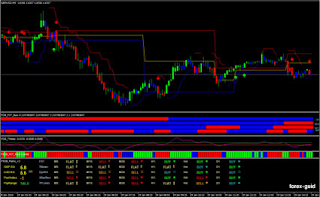For those unfamiliar with the term, Forex (FOReign EXchange market), refers to an international exchange market where currencies are bought and sold. The Foreign Exchange Market that we see today began in the 1970's, when free exchange rates and floating currencies were introduced. In such an environment only participants in the market determine the price of one currency against another, based upon supply and demand for that currency.
Forex is a somewhat unique market for a number of reasons. Firstly, it is one of the few markets in which it can be said with very few qualifications that it is free of external controls and that it cannot be manipulated. It is also the largest liquid financial market, with trade reaching between 1 and 1.5 trillion US dollars a day. With this much money moving this fast, it is clear why a single investor would find it near impossible to significantly affect the price of a major currency. Furthermore, the liquidity of the market means that unlike some rarely traded stock, traders are able to open and close positions within a few seconds as there are always willing buyers and sellers.
Another somewhat unique characteristic of the Forex money market is the variance of its participants. Investors find a number of reasons for entering the market, some as longer term hedge investors, while others utilize massive credit lines to seek large short term gains. Interestingly, unlike blue-chip stocks, which are usually most attractive only to the long term investor, the combination of rather constant but small daily fluctuations in currency prices, create an environment which attracts investors with a broad range of strategies.
How Forex Works
Transactions in foreign currencies are not centralized on an exchange, unlike say the NYSE, and thus take place all over the world via telecommunications. Trade is open 24 hours a day from Sunday afternoon until Friday afternoon (00:00 GMT on Monday to 10:00 pm GMT on Friday). In almost every time zone around the world, there are dealers who will quote all major currencies. After deciding what currency the investor would like to purchase, he or she does so via one of these dealers (some of which can be found online). It is quite common practice for investors to speculate on currency prices by getting a credit line (which are available to those with capital as small as $500), and vastly increase their potential gains and losses. This is called marginal trading.
Marginal Trading
Marginal trading is simply the term used for trading with borrowed capital. It is appealing because of the fact that in Forex investments can be made without a real money supply. This allows investors to invest much more money with fewer money transfer costs, and open bigger positions with a much smaller amount of actual capital. Thus, one can conduct relatively large transactions, very quickly and cheaply, with a small amount of initial capital. Marginal trading in an exchange market is quantified in lots. The term "lot" refers to approximately $100,000, an amount which can be obtained by putting up as little as 0.5% or $500.
EXAMPLE: You believe that signals in the market are indicating that the British Pound will go up against the US Dollar. You open 1 lot for buying the Pound with a 1% margin at the price of 1.49889 and wait for the exchange rate to climb. At some point in the future, your predictions come true and you decide to sell. You close the position at 1.5050 and earn 61 pips or about $405. Thus, on an initial capital investment of $1,000, you have made over 40% in profits. (Just as an example of how exchange rates change in the course of a day, an average daily change of the Euro (in Dollars) is about 70 to 100 pips.)
When you decide to close a position, the deposit sum that you originally made is returned to you and a calculation of your profits or losses is done. This profit or loss is then credited to your account.










